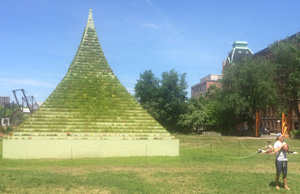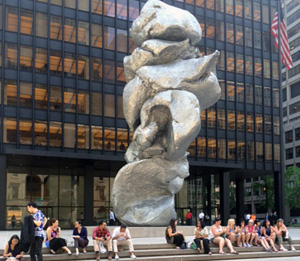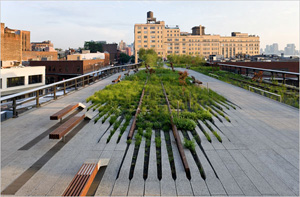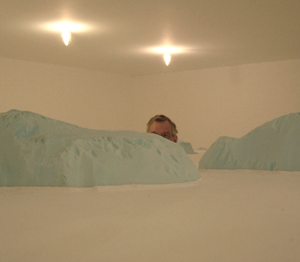Stepping Out
John Haberin New York City
Summer Sculpture 2015
Pierre Huyghe, Tatiana Trouvé, and Panorama
Summer in New York is a time for exploring. The days are long, the streets are quiet, and the parks fill with sculpture. So what if you run into a wall?
That may happen in Socrates Sculpture Park, where a ten-foot wall stands between the open-air market and the lawn. Just when you think things should be getting greener, what look like bare trees are poise to either side, connected by a steel cable and leaning away.  And just when you think things should be more open, a forty-foot pyramid lies beyond. Be careful, too, or you may fall into a sinkhole, if only an imagined one. Welcome to the big city, and prepare to move on—to Central Park, the High Line, and more. They implicitly question the idea of public sculpture, and not every artist stands in the way.
And just when you think things should be more open, a forty-foot pyramid lies beyond. Be careful, too, or you may fall into a sinkhole, if only an imagined one. Welcome to the big city, and prepare to move on—to Central Park, the High Line, and more. They implicitly question the idea of public sculpture, and not every artist stands in the way.
Not that Socrates Sculpture Park welcomes visitors with sculpture alone. Almost from the subway, half a mile away, one can see its "Broadway billboard" above the entrance as a 2D work of art. This summer, though it represents sculpture, although it looks more like life. Make that the afterlife, for the horses crossing it look like ghosts. Some are all the more vivid as ghostly silhouettes. Others might already have faded into the afternoon light.
Tread carefully
Look again, and the brightest have vertical poles running down the middle. Has the park acquired a carousel, like Brooklyn Bridge Park, with the billboard its advertisement? Once again the invitation to summer is misleading, unless you were expecting sculpture. Vera Lutter took to the National Gallery in Washington, where Edgar Degas has the same command of bodies in motion as with his dancers. The ghostly appearance of his sculpture arises from a camera obscura. The summer's four contemporary sculptors have to compete with centuries' old technology and a master.
They can compete on their own terms, though, starting with that cinder-block wall. Like the rest of the exhibition, it has more life than one may think. For Two Trees in Balance, Gabriela Albergaria stresses both natural growth and balance. She assembles the trees from found branches, spreading higher than the wall. As for the pyramid, Agnes Denes may seem to have reversed course since the days when her wheat field in Battery Park City associated civilization with cultivation rather than monuments. Yet flowers run along the lower tiers of The Living Pyramid, and grass slowly reaches for to the top.
The apparent sinkhole, too, may seem to betray the promise of summer in the parks. For Suspect Terrain, Heide Fasnacht builds something much like a concert stage, only to let it collapse under the weight of a pretend house at its center. Yet she sees it as nature recovering ground, much as with Merrill Wagner and earthworks, and the house falls within the painted illusion of water. IK Studio's Folly: Torquing Spheres presents another wall—an arc of eight plywood sections, each shaped like a dome. Yet each could represent a flower in bloom. They blend easily into the trees behind them by the waterfront, along with sculpture by a park founder, Mark di Suvero.
Prepared to tread carefully? Back in Manhattan, one had better. On the roof of the Met, Pierre Huyghe has taken up several of the large stone tiles and shunted them slightly to the side. And that is about it. Up where sculptors usually go for weight, like Anthony Caro and Frank Stella, or abundance, like Roxy Paine and Tomás Saraceno, Huyghe adds just a rock and a fishtank. The actual work might still be under construction—or the Met might have ordered him to leave room for parties at the rooftop bar.
In reality, he intends a "transformation of cultural and biological systems through a dynamic gathering of components." In other words, watch your step. A veteran of "relational esthetics," Huyghe invites the viewer and the site into the action, while never quite becoming site specific. Art, you see, is too important for that. The stone picks up on the very bedrock of Manhattan, and the fishtank, with two more stones inside along with fish, turns alternately clear and opaque thanks to the magic of digital materials. With a nod to summer in the city, Jeff Koons would at least have thrown in a basketball.
Actually, City Hall Park throws in both rubble and a basketball, thanks to Alice Channer and Hank Willis Thomas. She reconstrusts her rocks in concrete and aluminum, while his basketball balances on the finger and raised arm of a Harlem Globetrotter in automotive purple, as a sly take on Lady Liberty. All seven artists in "Image Object," including Lothar Hempel and Artie Vierkant, manipulate images for the computer era, like what could pass for marble by Henry Moore fallen off its pedestal, if only Moore used pedestals. Jon Rafman actually stretched conventional busts beyond recognition. While other takes on advertising verge on the conventional, such as Timur Si Qun's monument to peace with the phases of the moon as its logo, Amanda Ross-Ho returns to a classical portrait bust, based on an early photography manual, with a vengeance. And the woman's head, framed in neon and set between a cube and a sphere, does take its vengeance—against any male who dares to look away.
On and off the road
Back on the ground, ready to explore Central Park? Tatiana Trouvé is eager to show the way. Her map may be more cryptic than the ordinary one beside it, at the entrance to the park near the Plaza Hotel, but then it is a work of art. Dozens of giant spools rest on three large racks, with rope for their colored thread. One could mistake them for utility cable from the adjacent construction site, where the statue of General William Tecumseh Sherman riding to victory lies under a shroud for regilding. It stands for now as a Minimalist white box, like the ultimate in summer sculpture.
Trouvé's Desire Lines can hardly help being less obvious, but the idea of thread makes sense: she is bringing things together. The sizes of the spools and their length of rope correspond to the length of more than two hundred paths through the park, from about sixty feet to four miles. A label on each spool identifies the path's location while adding still further connections. The artist free associates on the notion of foot travel, leading her to such lines as March on Washington or Moon Walk. Like Central Park and its paths, her thoughts do not run in straight lines.
Trouvé does force her hand. Even the division of the park's vast networks into paths is arbitrary. Frederick Law Olmsted and Calvert Vaux would hardly recognize it, even without The Gates. The work's very title is a misnomer, as desire lines are tracks that people create by wandering off the pavement on their own.  Still, the landscape's physical, visual, and feminist manifestation as thread is impressive, as is the invitation to let its lengths uncurl under one's feet. My father would have appreciated that long ago, when he took me to the park—and told me that we were exploring.
Still, the landscape's physical, visual, and feminist manifestation as thread is impressive, as is the invitation to let its lengths uncurl under one's feet. My father would have appreciated that long ago, when he took me to the park—and told me that we were exploring.
Heading south alongside Park Avenue traffic, the exploration narrows, and desire lines become out of the question. Santiago Calatrava uses the median strip for his bright red and black arcs—somewhere between flowers, crabs, and monuments. Sometimes they find their way back to earth, sometimes not. Their Pop Art colors provide a degree of relief from their mass and from business as usual. And who knows? Late and over budget, his Path Station at Ground Zero, with all the engineering talent behind it, may yet unfold as well.
One arch also finds itself framing Big Clay #4—forty-two feet of aluminum blobs by Urs Fischer, in the plaza of the Seagram Building. (A photo released by Calatrava's dealer erases it, a charming reminder of the rivalry between big players in the market.) Calatrava's fun house also has a counterpart in Fischer's usual role as art's bad boy sticking out his tongue. Here the blobs look like a huge pile of turds or maybe elephants on their sides. In strong sunlight, they could be white elephants at that. Now if only they had the playfulness and search for form of their title.
To regain a sense of cities as desire lines, head to Madison Square Park. Teresita Fernández gives its paths a roof of mirrors, cut irregularly like clouds. They do not offer protection from the elements, but they put one all the more in touch with sunlight above and the shadows on the ground. The title, Fata Morgana, suggests that it is all a mirage, but also part of a broader landscape, more remote and closer to the sky. New Yorkers can continue the hunt for summer art and illusion in Brooklyn Bridge Park, with Jeppe Hein and his kid-friendly fountain, playful park benches, and Mirror Labyrinth of reflective verticals and fresh air. Or they can return to the straight and narrow in Chelsea.
New York inside and out
The High Line weaves through New York, preserving its past while looking to its future. Set on an elevated freight line, it refuses to let go of a time when west Chelsea held manufacturing rather than galleries—a time, in fact, when no one called it Chelsea. Its wildflowers still look much like weeds. And then it looks down on those very galleries, in a city of landmarks past and present. When it is complete, it will run from the new Whitney Museum to the luxury development of Hudson Yards. Already its route offers a choice between water towers and wealthy condos, like a parable of gentrification.
At the same time, the High Line steps out of New York, leaving the streets in its shadow. It discards the spontaneity of the streets as well, in favor of a march in lock step along its narrow, crowded length. A concrete box by Adrián Villar Rojas, set in its still undeveloped northern end as The Evolution of God, even places it outside of time. Call it a park if you will, but New Yorkers are not here to lie or to play in the sun.  Much like the Meatpacking District at its base, it attracts mostly tourists and the "bridge and tunnel" crowd, out for a prepackaged image of the city and a drink. No wonder other urban centers hope to replicate it.
Much like the Meatpacking District at its base, it attracts mostly tourists and the "bridge and tunnel" crowd, out for a prepackaged image of the city and a drink. No wonder other urban centers hope to replicate it.
The High Line calls its 2015 summer sculpture "Panorama," but which panorama will it offer? Its eleven artists, too, have a choice. A fashionably international cast, they can call upon the urban landscape or distant memories of home, like awnings for Nicole Wermers. Either way, they find themselves at one remove, and so will visitors. The entire experience is a like a treasure hunt, with art where one least expects it. The cranes for construction projects nearby look like part of the show.
Not every artist feels obliged to choose. Katrín Sigurdardóttir places her sculpture under the High Line, clinging to it for support, much as she once placed art above a drop ceiling. Her rough white slab could represent the glacial, volcanic landscape of her native Iceland—or the slow accretion of rainwater through the rails. Olafur Eliasson invites kids to create their own panorama, from white Lego. Rashid Johnson (like Eliasson, not strictly a part of the show) brings his shelf of yellow heads from Harlem, and they fit right in. Others, though, face up to dislocation.
Mariana Castillo Deball means her totems to recall Mexican pottery, but as archaeology or fairy tale. Andro Wekua blackens a window from his childhood in Georgia. It leaves him caught between Communism and capitalism, Asia and Eastern Europe, Europe and America, fragile shelters and closed vistas. Kris Martin has a more high-minded view of home, with the outlines of a Northern Renaissance altarpiece by Jan and Hubert van Eyck.  Yet he, too, lives between worlds. His steel framework also recalls David Smith, while permitting a window away from Smith's Hudson River Landscape and onto Chelsea.
Yet he, too, lives between worlds. His steel framework also recalls David Smith, while permitting a window away from Smith's Hudson River Landscape and onto Chelsea.
The rest dive into New York, recognizable or not. Gabriel Sierra creates "custom tools" to measure it, while Elmgreen and Dragset promise a close-up through a telescope aimed at nothing. Damián Ortega riffs on urban graffiti, Kaari Upson assembles her city from Pepsi cans, and Ryan Gander leaves out a bronze iPhone and wallet like stolen goods. Yutaka Sone carves Manhattan in marble, like the model from the 1964 World's Fair, but with a cliff of white bedrock protruding below. When it comes to a sense of place, though, one might do better beyond "Panorama"—with long-term installations and an eye to today. Spencer Finch chose his colored glass to match sunlight on the Hudson that not even summer's end can dispel.

Outdoor sculpture ran in Socrates Sculpture Park through August 2015, Pierre Huyghe at The Metropolitan Museum of Art through October, "Image Object" in City Hall Park through November, Tatiana Trouvé at Grand Army Plaza through August, Santiago Calatrava along Park Avenue through mid-November, and Urs Fischer at the Seagram Building on Park through August. Teresita Fernández ran in Madison Square Park through February 2016, Jeppe Hein in Brooklyn Bridge Park through mid-April, and "Panorama" on the High Line through March. I continue to follow summer sculpture as in past years going back to summer 2003 and continuing through summer 2016, summer 2017, summer 2018, summer 2019, summer 2020 and its extension into fall, summer 2021, summer 2022, summer 2023, and summer 2024, including Katharina Grosse at Rockaway Beach.




